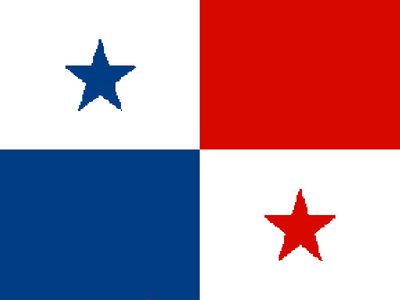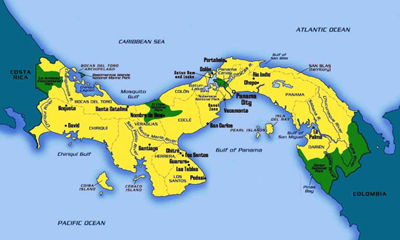PANAMÁ
|
|
|
NAME: República
de Panamá
POPULATION: 3,300,000
(2007)
ETHNIC GROUPS: Mestizo and White (70%); Mulatto (14%); Amerindian (6%)
CAPITAL: Panamá,
2,000,000)
LANGUAGES: Official
language: Spanish
RELIGION: Roman
Catholic (85%)
LIFE EXPECTANCY: Men (73); women (78)
LITERACY: 92%
GOVERNMENT: Democratic
constitutional republic
President: Torrijos Espino
Legislature: Unicameral
Asamblea Nacional
MILITARY: No
regular military forces
ECONOMY: Exports:
bananas, shrimp, sugar, coffee, and clothing
MONEY: balboa
(PAB), which is pegged directly to the US dollar (USD) (1.00 PAB = $1.00 US)
GEOGRAPHY: Panamá
is bordered by
INTERNET
CODE: .pa
HISTORY:
11,000 BCE (or
up to 34,000 BCE): pre-Colombian settlers
500-900 CE Conte
civilization with polychrome potter in the Coclé style
1821 Panamá
got its independence from
República de Gran
1830 Panamá
remained a part of
1903 Panamá
seceded from
1904-1914 The
1977 Under
President Jimmy Carter of the
1983-1989 Gen. Manuel Noriega seized power.
1989 The US Army invaded Pananá and seized presidential dictator Manuel Noriega on the grounds that he was supporting drug traffickers.
2004 Martin Torrijos Espino elected president.
2006
PRINCIPAL
POLITICAL PARTIES:
Democratic Change (CD)
Democratic Revolutionary Party (PRD)
Nationalist Republican Liberal Movement (MOLIRENA)
Panamenista Party (PA)
Patriotic Union Party (PU)
Popular
Party (PP)
CULTURE:
Synchretism
of European humanities with African and Amerindian cultures. A famous
Panamanian dance is the tamborito, which fuses an originally Spanish dance with
Amerindian rhythms, music, and choreography. Panamá also features dance
and music derived from jazz, blues, salsa, reggae, and contemporary rock. Crafts
such as basket weaving, woodcarving and pottery are prominent. A piece of
clothing called the mola (a woman's
blouse) is derived from patterns created by the Kuna Indians.



